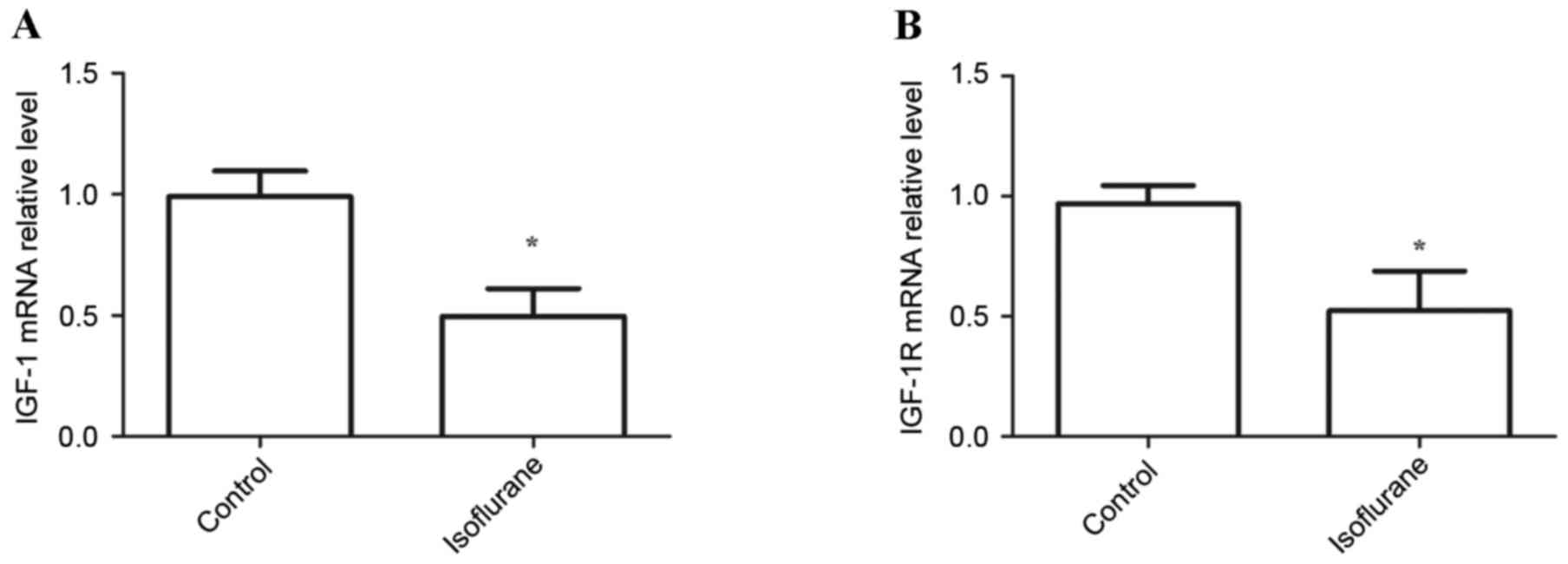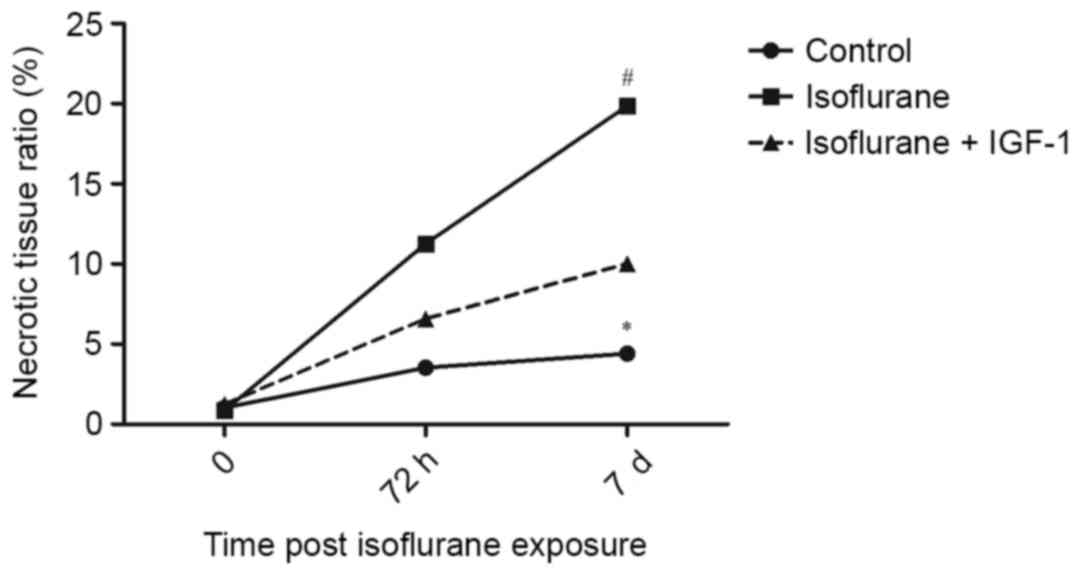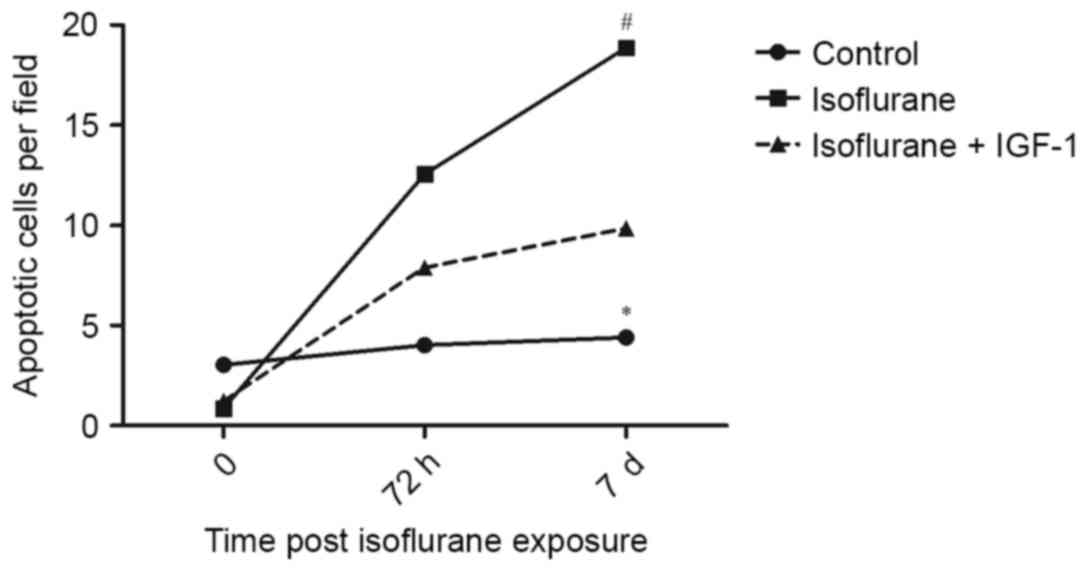|
1
|
Njoku D, Laster MJ, Gong DH, Eger EI II,
Reed GF and Martin JL: Biotransformation of halothane, enflurane,
isoflurane, and desflurane to trifluoroacetylated liver proteins:
Association between protein acylation and hepatic injury. Anesth
Analg. 84:173–178. 1997. View Article : Google Scholar : PubMed/NCBI
|
|
2
|
Wright R, Eade OE, Chisholm M, Hawksley M,
Lloyd B, Moles TM, Edwards JC and GArdner MJ: Controlled
prospective study of the effect on liver function of multiple
exposures to halothane. Lancet. 1:817–820. 1975. View Article : Google Scholar : PubMed/NCBI
|
|
3
|
Suliburk JW, Gonzalez EA, Kennison SD,
Helmer KS and Mercer DW: Differential effects of anesthetics on
endotoxin-induced liver injury. J Trauma. 58:711–717. 2005.
View Article : Google Scholar : PubMed/NCBI
|
|
4
|
Mohseni M, Safari S and Alavian SM:
Volatile anesthetics in ischemic liver injury: Enemy or friend?
Hepat Mon. 14:e198802014. View Article : Google Scholar : PubMed/NCBI
|
|
5
|
Gunza JT and Pashayan AG: Postoperative
elevation of serum transaminases following isoflurane anesthesia. J
Clin Anesth. 4:336–341. 1992. View Article : Google Scholar : PubMed/NCBI
|
|
6
|
Brunt EM, White H, Marsh JW, Holtmann B
and Peters MG: Fulminant hepatic failure after repeated exposure to
isoflurane anesthesia: A case report. Hepatology. 13:1017–1021.
1991. View Article : Google Scholar : PubMed/NCBI
|
|
7
|
Turner GB, O'Rourke D, Scott GO and
Beringer TR: Fatal hepatotoxicity after re-exposure to isoflurane:
A case report and review of the literature. Eur J Gastroenterol
Hepatol. 12:955–959. 2000. View Article : Google Scholar : PubMed/NCBI
|
|
8
|
Carrigan TW and Straughen WJ: A report of
hepatic necrosis and death following isoflurane anesthesia.
Anesthesiology. 67:581–583. 1987. View Article : Google Scholar : PubMed/NCBI
|
|
9
|
Dabbagh A and Rajaei S: The role of
anesthetic drugs in liver apoptosis. Hepat Mon. 13:e131622013.
View Article : Google Scholar : PubMed/NCBI
|
|
10
|
Gelven PL, Cina SJ, Lee JD and Nichols CA:
Massive hepatic necrosis and death following repeated isoflurane
exposure: Case report and review of the literature. Am J Forensic
Med Pathol. 17:61–64. 1996. View Article : Google Scholar : PubMed/NCBI
|
|
11
|
Kaseb AO, Morris JS, Hassan MM, Siddiqui
AM, Lin E, Xiao L, Abdalla EK, Vauthey JN, Aloia TA, Krishnan S and
Abbruzzese JL: Clinical and prognostic implications of plasma
insulin-like growth factor-1 and vascular endothelial growth factor
in patients with hepatocellular carcinoma. J Clin Oncol.
29:3892–3899. 2011. View Article : Google Scholar : PubMed/NCBI
|
|
12
|
Sanz S, Pucilowska JB, Liu S,
Rodríguez-Ortigosa CM, Lund PK, Brenner DA, Fuller CR, Simmons JG,
Pardo A, Martínez-Chantar ML, et al: Expression of insulin-like
growth factor I by activated hepatic stellate cells reduces
fibrogenesis and enhances regeneration after liver injury. Gut.
54:134–141. 2005. View Article : Google Scholar : PubMed/NCBI
|
|
13
|
Svegliati-Baroni G, Ridolfi F, Di Sario A,
Casini A, Marucci L, Gaggiotti G, Orlandoni P, Macarri G, Perego L,
Benedetti A and Folli F: Insulin and insulin-like growth factor-1
stimulate proliferation and type I collagen accumulation by human
hepatic stellate cells: Differential effects on signal transduction
pathways. Hepatology. 29:1743–1751. 1999. View Article : Google Scholar : PubMed/NCBI
|
|
14
|
Aksu I, Baykara B, Kiray M, Gurpinar T,
Sisman AR, Ekerbicer N, Tas A, Gokdemir-Yazar O and Uysal N: Serum
IGF-1 levels correlate negatively to liver damage in diabetic rats.
Biotech Histochem. 88:194–201. 2013. View Article : Google Scholar : PubMed/NCBI
|
|
15
|
Rehem RN and El-Shikh WM: Serum IGF-1,
IGF-2 and IGFBP-3 as parameters in the assessment of liver
dysfunction in patients with hepatic cirrhosis and in the diagnosis
of hepatocellular carcinoma. Hepatogastroenterology. 58:949–954.
2011.PubMed/NCBI
|
|
16
|
Clemmons DR: Metabolic actions of
insulin-like growth factor-I in normal physiology and diabetes.
Endocrinol Metab Clin North Am. 41:425-443, vii-viii2012.
View Article : Google Scholar
|
|
17
|
Friedman SL: Molecular regulation of
hepatic fibrosis, an integrated cellular response to tissue injury.
J Biol Chem. 275:2247–2250. 2000. View Article : Google Scholar : PubMed/NCBI
|
|
18
|
Pinzani M, Abboud HE and Aron DC:
Secretion of insulin-like growth factor-I and binding proteins by
rat liver fat-storing cells: Regulatory role of platelet-derived
growth factor. Endocrinology. 127:2343–2349. 1990. View Article : Google Scholar : PubMed/NCBI
|
|
19
|
Picardi A, de Oliveira AC, Muguerza B,
Tosar A, Quiroga J, Castilla-Cortázar I, Santidrián S and Prieto J:
Low doses of insulin-like growth factor-I improve nitrogen
retention and food efficiency in rats with early cirrhosis. J
Hepatol. 26:191–202. 1997. View Article : Google Scholar : PubMed/NCBI
|
|
20
|
Edmands SD, Ladow E and Hall AC:
Microarray analyses of genes regulated by isoflurane anesthesia in
vivo: A novel approach to identifying potential preconditioning
mechanisms. Anesth Analg. 116:589–595. 2013. View Article : Google Scholar : PubMed/NCBI
|
|
21
|
Vaquero J, Bélanger M, James L, Herrero R,
Desjardins P, Côté J, Blei AT and Butterworth RF: Mild hypothermia
attenuates liver injury and improves survival in mice with
acetaminophen toxicity. Gastroenterology. 132:372–383. 2007.
View Article : Google Scholar : PubMed/NCBI
|
|
22
|
Livak KJ and Schmittgen TD: Analysis of
relative gene expression data using real-time quantitative PCR and
the 2(−Delta Delta C(T)) Method. Methods. 25:402–408. 2001.
View Article : Google Scholar : PubMed/NCBI
|
|
23
|
Ozier Y and Klinck JR: Anesthetic
management of hepatic transplantation. Curr Opin Anaesthesiol.
21:391–400. 2008. View Article : Google Scholar : PubMed/NCBI
|
|
24
|
Stoelting RK: Isoflurane and postoperative
hepatic dysfunction. Can J Anaesth. 34:223–226. 1987.(In English,
French). View Article : Google Scholar : PubMed/NCBI
|
|
25
|
Sinha A, Clatch RJ, Stuck G, Blumenthal SA
and Patel SA: Isoflurane hepatotoxicity: A case report and review
of the literature. Am J Gastroenterol. 91:2406–2409.
1996.PubMed/NCBI
|
|
26
|
Weitz J, Kienle P, Böhrer H, Hofmann W,
Theilmann L and Otto G: Fatal hepatic necrosis after isoflurane
anaesthesia. Anaesthesia. 52:892–895. 1997. View Article : Google Scholar : PubMed/NCBI
|
|
27
|
Cheng L, You Q, Yin H, Holt M, Franklin C
and Ju C: Effect of polyI: C cotreatment on halothane-induced liver
injury in mice. Hepatology. 49:215–226. 2009. View Article : Google Scholar : PubMed/NCBI
|
|
28
|
Jaeschke H, Gujral JS and Bajt ML:
Apoptosis and necrosis in liver disease. Liver Int. 24:85–89. 2004.
View Article : Google Scholar : PubMed/NCBI
|
|
29
|
Takahashi Y: Essential roles of growth
hormone (GH) and insulin-like growth factor-I (IGF-I) in the liver.
Endocr J. 59:955–962. 2012. View Article : Google Scholar : PubMed/NCBI
|
|
30
|
Bonefeld K and Møller S: Insulin-like
growth factor-I and the liver. Liver Int. 31:911–919. 2011.
View Article : Google Scholar : PubMed/NCBI
|
|
31
|
Caro JF, Poulos J, Ittoop O, Pories WJ,
Flickinger EG and Sinha MK: Insulin-like growth factor I binding in
hepatocytes from human liver, human hepatoma, and normal,
regenerating, and fetal rat liver. J Clin Invest. 81:976–981. 1988.
View Article : Google Scholar : PubMed/NCBI
|
|
32
|
Stefano JT, Correa-Giannella ML, Ribeiro
CM, Alves VA, Massarollo PC, Machado MC and Giannella-Neto D:
Increased hepatic expression of insulin-like growth factor-I
receptor in chronic hepatitis C. World J Gastroenterol.
12:3821–3828. 2006. View Article : Google Scholar : PubMed/NCBI
|
|
33
|
Kim SO, Park JG and Lee YI: Increased
expression of the insulin-like growth factor I (IGF-I) receptor
gene in hepatocellular carcinoma cell lines: Implications of IGF-I
receptor gene activation by hepatitis B virus X gene product.
Cancer Res. 56:3831–3836. 1996.PubMed/NCBI
|
|
34
|
Bugianesi E, McCullough AJ and Marchesini
G: Insulin resistance: A metabolic pathway to chronic liver
disease. Hepatology. 42:987–1000. 2005. View Article : Google Scholar : PubMed/NCBI
|
|
35
|
Mantena SK, King AL, Andringa KK,
Eccleston HB and Bailey SM: Mitochondrial dysfunction and oxidative
stress in the pathogenesis of alcohol- and obesity-induced fatty
liver diseases. Free Radic Biol Med. 44:1259–1272. 2008. View Article : Google Scholar : PubMed/NCBI
|
|
36
|
Yakar S, Liu JL, Fernandez AM, Wu Y,
Schally AV, Frystyk J, Chernausek SD, Mejia W and Le Roith D:
Liver-specific igf-1 gene deletion leads to muscle insulin
insensitivity. Diabetes. 50:1110–1118. 2001. View Article : Google Scholar : PubMed/NCBI
|
|
37
|
Conchillo M, de Knegt RJ, Payeras M,
Quiroga J, Sangro B, Herrero JI, Castilla-Cortazar I, Frystyk J,
Flyvbjerg A, Yoshizawa C, et al: Insulin-like growth factor I
(IGF-I) replacement therapy increases albumin concentration in
liver cirrhosis: Results of a pilot randomized controlled clinical
trial. J Hepatol. 43:630–636. 2005. View Article : Google Scholar : PubMed/NCBI
|
|
38
|
Hao CN, Geng YJ, Li F, Yang T, Su DF, Duan
JL and Li Y: Insulin-like growth factor-1 receptor activation
prevents hydrogen peroxide-induced oxidative stress, mitochondrial
dysfunction and apoptosis. Apoptosis. 16:1118–1127. 2011.
View Article : Google Scholar : PubMed/NCBI
|
|
39
|
Nishizawa H, Takahashi M, Fukuoka H,
Iguchi G, Kitazawa R and Takahashi Y: GH-independent IGF-I action
is essential to prevent the development of nonalcoholic
steatohepatitis in a GH-deficient rat model. Biochem Biophys Res
Commun. 423:295–300. 2012. View Article : Google Scholar : PubMed/NCBI
|
|
40
|
Pérez R, Garcia-Fernández M, Díaz-Sánchez
M, Puche JE, Delgado G, Conchillo M and Muntané J and
Castilla-Cortázar I: Mitochondrial protection by low doses of
insulin-like growth factor-I in experimental cirrhosis. World J
Gastroenterol. 14:2731–2739. 2008. View Article : Google Scholar : PubMed/NCBI
|
|
41
|
Canbay A, Feldstein AE, Higuchi H,
Werneburg N, Grambihler A, Bronk SF and Gores GJ: Kupffer cell
engulfment of apoptotic bodies stimulates death ligand and cytokine
expression. Hepatology. 38:1188–1198. 2003. View Article : Google Scholar : PubMed/NCBI
|
|
42
|
Sattler M, Liang H, Nettesheim D, Meadows
RP, Harlan JE, Eberstadt M, Yoon HS, Shuker SB, Chang BS, Minn AJ,
et al: Structure of Bcl-xL-Bak peptide complex: Recognition between
regulators of apoptosis. Science. 275:983–986. 1997. View Article : Google Scholar : PubMed/NCBI
|
|
43
|
Ku B, Liang C, Jung JU and Oh BH: Evidence
that inhibition of BAX activation by BCL-2 involves its tight and
preferential interaction with the BH3 domain of BAX. Cell Res.
21:627–641. 2011. View Article : Google Scholar : PubMed/NCBI
|
|
44
|
Gottschalk S, Zwingmann C, Raymond VA,
Hohnholt MC, Chan TS and Bilodeau M: Hepatocellular apoptosis in
mice is associated with early upregulation of mitochondrial glucose
metabolism. Apoptosis. 17:143–153. 2012. View Article : Google Scholar : PubMed/NCBI
|
|
45
|
Dejean LM, Ryu SY, Martinez-Caballero S,
Teijido O, Peixoto PM and Kinnally KW: MAC and Bcl-2 family
proteins conspire in a deadly plot. Biochim Biophys Acta.
1797:1231–1238. 2010. View Article : Google Scholar : PubMed/NCBI
|
|
46
|
Stevens MF, Werdehausen R, Gaza N,
Hermanns H, Kremer D, Bauer I, Küry P, Hollmann MW and Braun S:
Midazolam activates the intrinsic pathway of apoptosis independent
of benzodiazepine and death receptor signaling. Reg Anesth Pain
Med. 36:343–349. 2011. View Article : Google Scholar : PubMed/NCBI
|
|
47
|
Porter AG and Jänicke RU: Emerging roles
of caspase-3 in apoptosis. Cell Death Differ. 6:99–104. 1999.
View Article : Google Scholar : PubMed/NCBI
|



















